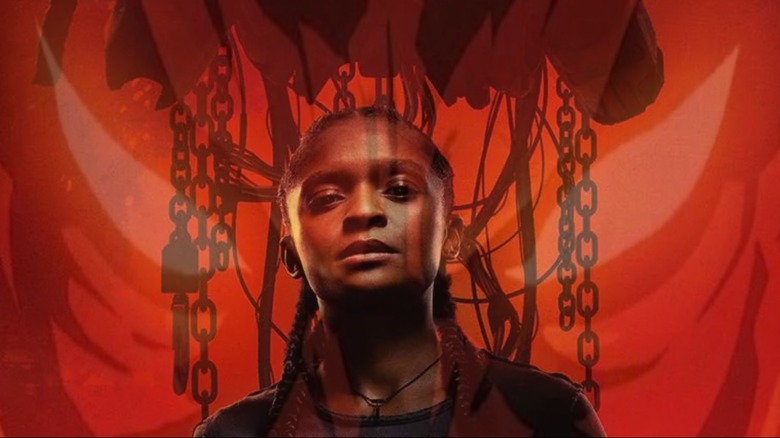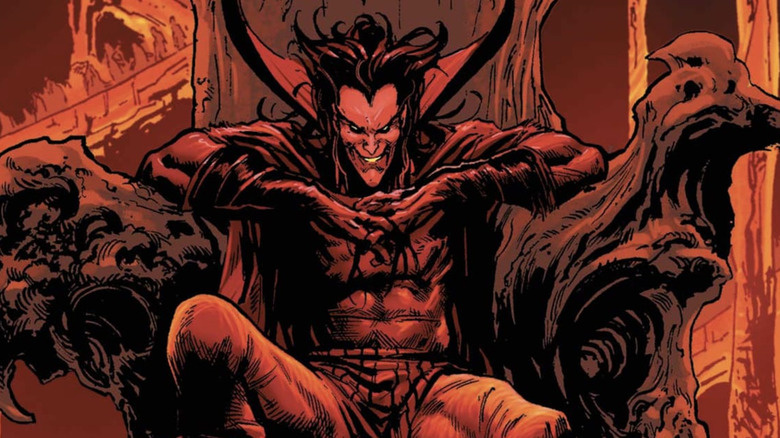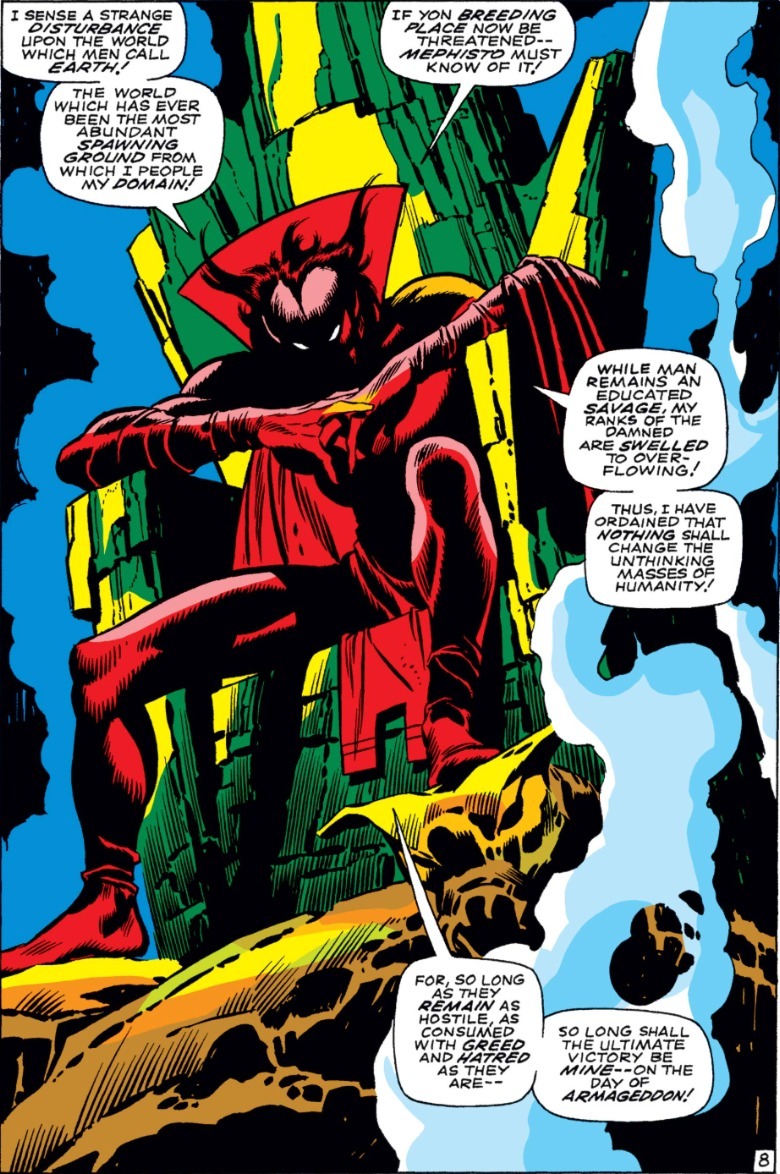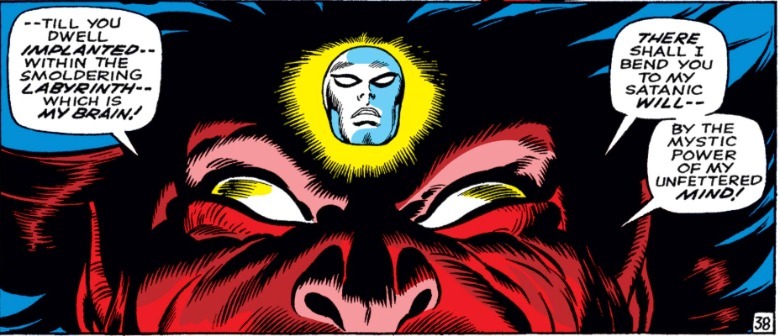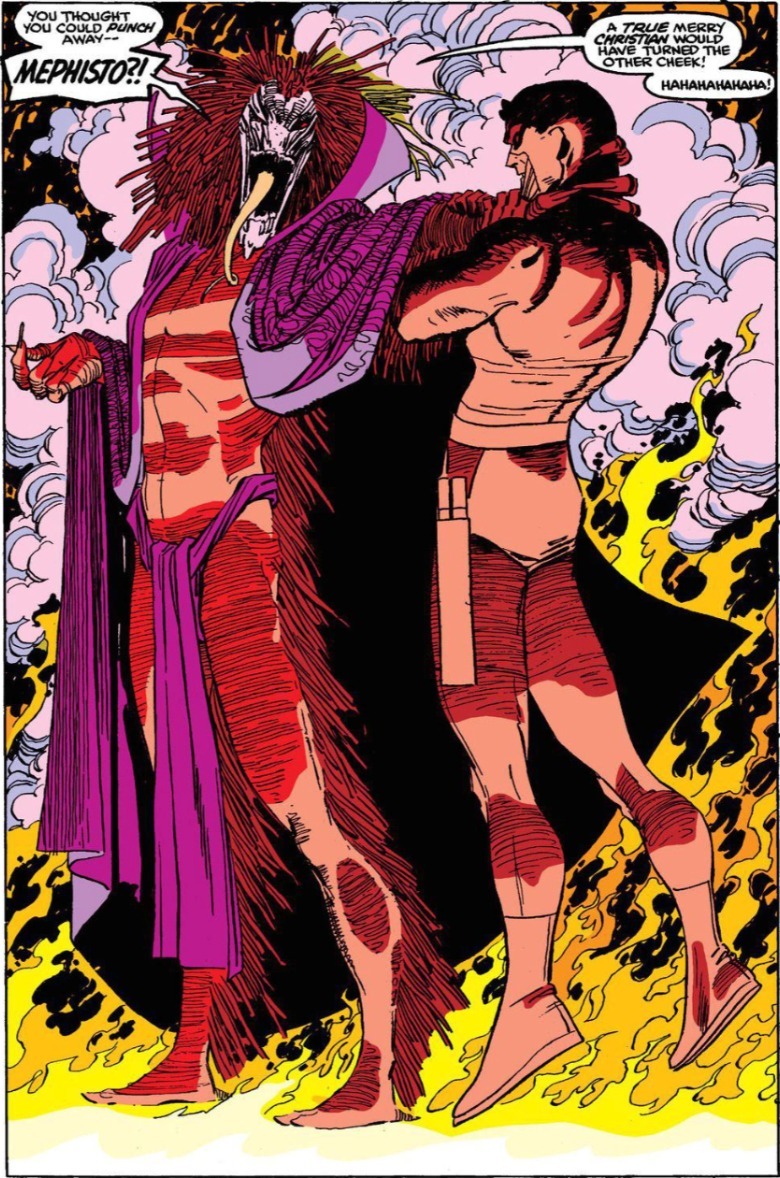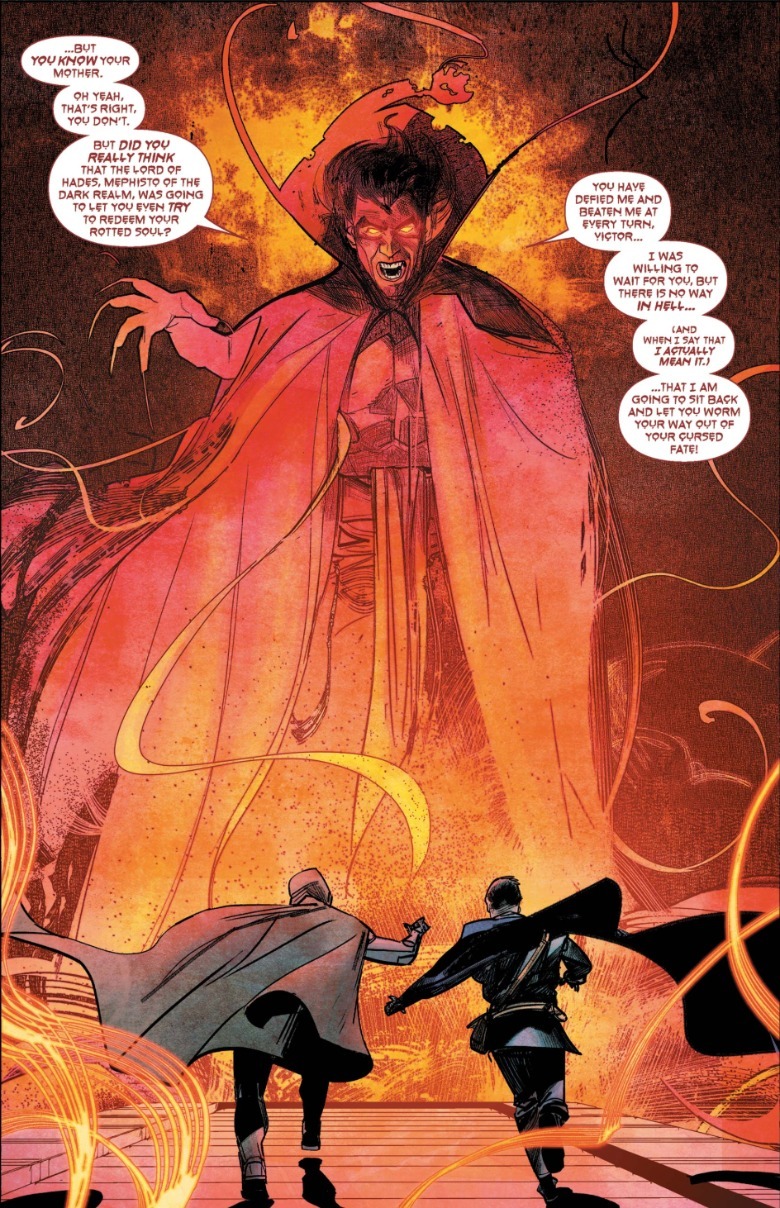Ironheart Features The MCU Debut Of A Long-Awaited Marvel Villain
We may receive a commission on purchases made from links.
Spoilers for "Ironheart" to follow.
"Ironheart" brings technology and magic into conflict: Our heroic young genius Riri Williams (Dominique Thorne) pilots an armored suit modeled after Iron Man, but the series' primary villain is Parker Robbins (Anthony Ramos), a wizard gang leader called the Hood because of the red hooded cloak he wears. (His name may not be magic, but his powers are.)
In the comics, the Hood's powers come from the Dread Dormammu, ruler of the Dark Dimension (and last seen in 2016's "Doctor Strange"). But in "Ironheart," Dormammu is a red herring. Parker got his hood from a different infernal power. Its name is one MCU fans will recognize from countless YouTube fan theory videos stretching all the way back to 2021's "WandaVision."
"Ironheart" episode 6 opens on a flashback that takes place before Parker broke bad. He's in a pizza parlor, talking with a man (Sacha Baron Cohen) whose name he, and we, don't know. But from his snazzy suit, you can tell Cohen's character is a man of wealth and taste. He asks Parker what he wants, and when the young man answers "filthy, disgusting" riches and power, they shake hands and his benefactor leaves him the Hood.
But by episode 6, Mr. Anonymous isn't too impressed with the Hood or his pleas for even more power. So, he invites Riri to share a slice with him. He makes deals with exceptional people to help them realize their potential, he explains: his partners include billionaires, kings, popes, and a Beatle (Ringo). Riri is "exceptional," and he wants them to work together. When Riri assumes and calls him "Dormammu," he can only laugh.
He has many names, he explains, but the one he gives Riri is "Mephisto." Cue an ominous choir soundtrack rising, but it cuts out when the implications of the name soar over Riri's head. She starts listening, though, when Mephisto's offer becomes apparent: He can bring back her dead friend, Natalie (Lyric Ross). The scene cuts away from Riri going to shake Mephisto's outstretched hand, but the last scene shows Riri hugging Natalie as a vein under her skin turns red, just like the Hood.
In the long history of Marvel Comics, Ironheart is far from the first character tempted by Mephisto.
Sacha Baron Cohen's Mephisto is Marvel's version of the Devil
Created by Stan Lee and artist John Buscema, Mephisto debuted in 1968's "Silver Surfer" #3. Ruler of a Hell dimension, he takes an interest in the Silver Surfer; the Surfer's noble heart is the mirror image of Mephisto's own, so he wants to vanquish it. Lee and Buscema's "Silver Surfer" primarily focuses on its heroes feeling disillusioned with humanity's violent and hateful ways. Who else could be the Surfer's main adversary than the one inducing people to give into their hearts' darkness?
Mephisto returned a few more times in the title's 18 issues and has since become a Marvel Comics fixture. He's not bound to a single book's ensemble but is more of a general evil that many superheroes have had to contend with. (Why else would he be debuting in "Ironheart," of all places?)
Mephisto's name comes from the legend of Faust or the original deal with the Devil story. Faust, a learned man, sells his soul to the demon Mephistopheles. Nowadays, Mephistopheles is often equated with Lucifer/Satan, even though in the Faust story he technically isn't the same being. The same distinction can be made between Marvel's Mephisto and the Devil.
As a young boy, I owned an edition of "The Marvel Encyclopedia," an often-updated book going through the Marvel universe's characters A-Z. In Mephisto's entry, I read (paraphrased from memory): "He is not the biblical Satan and his domain is not the Hell of scripture." "Why?" I thought. He's so clearly the Devil, why obfuscate that?
Well, remember that Mephisto debuted in 1968. The Comics Code Authority (CCA), instituted in 1954 in response to accusations comics were feeding kids subversive and illicit themes, was still in effect. The CCA explicitly prohibited horror, monsters, and "ridicule" of any religion. Lee and Buscema calling their Devil character "Mephisto" reeks of plausible deniability; it's a more obscure name than Satan, Lucifer, or just the Devil. At the same time, Mephisto explicitly refers to "his Satanic will" in "Silver Surfer" #3, so they weren't hiding it that hard.
The CCA is no longer a factor these days, but why have Marvel writers kept up the song and dance that Mephisto isn't the real Devil? Probably because it's safer, and more universal, to not so explicitly tie the Marvel universe's cosmology to Christian ideas. Compare Mephisto to HIM (Tom Kane) in "The Powerpuff Girls." A kids' show like that couldn't say he's the Devil for cultural sensitivity reasons, but we all know who he's supposed to be.
In any case, Lee and Buscema lifting the name from "Faust" reflects how Mephisto is characterized. Mephisto stories focus much more on the "ruler of Hell, corrupter of souls" side of Lucifer than the "fallen angel" side.
Marvel heroes who have danced with Mephisto in the pale moonlight
Mephisto's rivalry with the Silver Surfer earned him a place in Jim Starlin and George Pérez's "The Infinity Gauntlet." Thanos is strong and wise enough to spot Mephisto's ambition and reject his poisonous whispers. (To all the powerscalers asking if this means Josh Brolin's Thanos could "beat" Cohen's Mephisto in a fight: I don't care, and neither should you!)
Another Marvel hero who's got a long history with Mephisto is Ghost Rider. Motorcycle stunt artist Johnny Blaze made a deal with the Devil (retconned into Mephisto) to save his father from dying of cancer. Instead, Blaze Sr. just died in a stunt gone wrong. To fulfill his end of the deal, Blaze was bonded to the demon Zarathos and sentenced to hunt the wicked.
Mephisto's presence in Ghost Rider's backstory is what got him his previous live-action appearances: 2007's "Ghost Rider" (played by Peter Fonda) and 2011's "Ghost Rider: Spirit of Vengeance" (now portrayed by Ciarán Hinds). Like Cohen in "Ironheart," those movies didn't bother trying to recreate Buscema's caped red-skinned demon and depicted Mephisto wearing the guise of a human.
Since Marvel has a Catholic superhero called "Daredevil," it was only inevitable he'd fight with the actual Devil. In Ann Nocenti and John Romita Jr.'s late '80s/early '90s "Daredevil" run, Mephisto is out to corrupt Matt Murdock's soul, playing on the already deep pit of rage and violence within him. Romita redesigned Mephisto, giving him a snake-like head and tongue. Stories since then have gone back to Buscema's elfin look, but Mephisto is a shapeshifter.
One of the Marvel characters who most loathes Mephisto is another villain: Doctor Victor von Doom. Victor's mother Cynthia was a witch; when she died, Mephisto claimed her soul. Doom spent years trying to rescue her, succeeding in the 1989 comic "Doctor Strange and Doctor Doom: Triumph and Torment," written by Roger Stern and drawn by Mike Mignola (getting a taste for drawing demons years before he created Hellboy).
In the 2015 comic "Infamous Iron Man" (by Ironheart's co-creator Brian Michael Bendis and also artist Alex Maleev), Doom tries to become a hero. Mephisto's hatred of Doom had been sated because he knew Doom's soul would be his, and he also values Doom as one of evil's greatest servants on Earth. So, he refuses to "let [Doom] worm [his] way out of [his] cursed fate."
Tragically, Mephisto gets his wish. In "Invincible Iron Man" #600, the Hood re-scars Victor's healed face, turning him back into a masked tyrant. Mephisto's most infamous victory, though, is in 2007's "Spider-Man: One More Day," the worst Spider-Man story ever told. Long and short of it: Peter and MJ allow Mephisto to erase their marriage from history in exchange for a dying Aunt May's life. It's a story that makes Mephisto petty in all the wrong ways, so hopefully we won't see Cohen's Mephisto crossing paths with Tom Holland's Spider-Man anytime soon.
"Ironheart" is streaming on Disney+.
